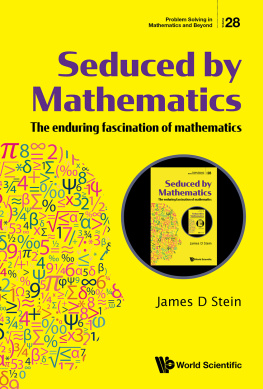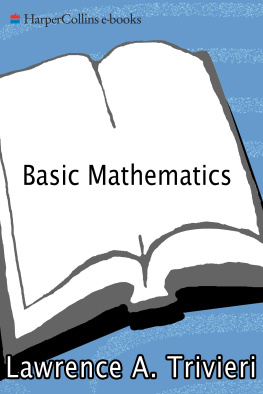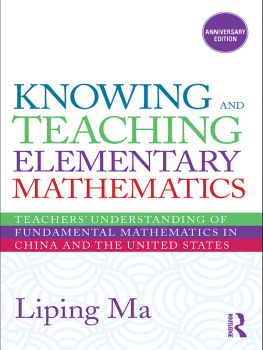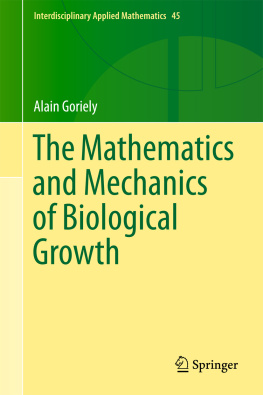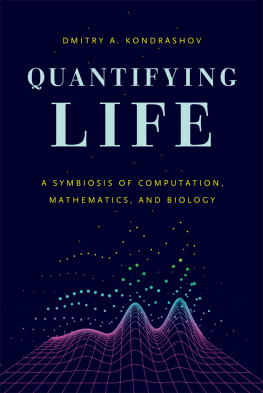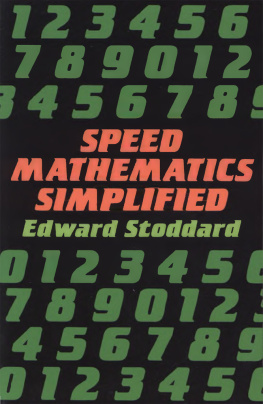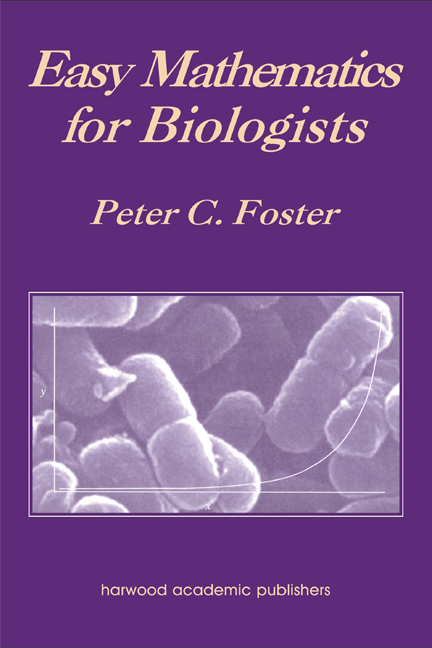
Easy Mathematics for Biologists
 Easy Mathematics for BiologistsPeter C.FosterDepartment of Applied BiologyUniversity of Central LancashirePrestonUKharwood academic publishers
Easy Mathematics for BiologistsPeter C.FosterDepartment of Applied BiologyUniversity of Central LancashirePrestonUKharwood academic publishers
Australia Canada France Germany India Japan
Luxembourg Malaysia The Netherlands Russia
Singapore Switzerland
Copyright 1998 OPA (Overseas Publishers Association) N.V. Published by
license under the Harwood Academic Publishers imprint, part of The Gordon and
Breach Publishing Group.
All rights reserved.
First published 1998
This edition published in the Taylor & Francis e-Library, 2003.
No part of this book may be reproduced or utilized in any form or by any means,
electronic or mechanical, including photocopying and recording, or by any
information storage or retrieval system, without permission in writing from the
publisher. Printed in Singapore.
Amsteldijk 166
1st Floor
1079 LH Amsterdam
The Netherlands
British Library Cataloguing in Publication Data A catalogue record for this book is available from the British Library.
ISBN 0-203-30430-6 Master e-book ISBN
ISBN 0-203-34408-1 (Adobe eReader Format)
ISBN: 9057023393 (softcover)
ContentsPrefaceIntroduction 1.1
How to Use this Book
1.2
Understanding a ProblemWhat You Need to Know
Measurements and Units: Fractions, Decimals and Percentages 2.1
Measurements and Units
2.2
Fractions
2.3
Decimals
2.4
Percentages
2.5
Problems
Ratio and Proportion: Amounts, Volumes and Concentrations 3.1
Introduction to Ratios and Proportions
3.2
Molarity
3.3
Dilutions
3.4
Concentration, Volume and Amount
3.5
Concentrations and Dilutions in Practice
3.6
Problems
Exponents and Prefixes: Scientific Notation, Conversion of Unitsand More
on Concentrations 4.1
Introduction
4.2
Exponents and Scientific Notation
4.3
Metric Prefixes: Changing the Units
4.4
Problems
Solving Equations and Evaluating Expressions 5.1
Solving Equations
5.2
Evaluating Expressions
5.3
Problems
Logarithms 6.1
Logarithms and Exponents
v
vi
Contents
6.2
Manipulating Logs
6.3
Problems
Straight-Line Graphs: Calibration Curves and Linear Rates
of Change 7.1
Proportional Relationships
7.2
Equations of Straight Lines
7.3
Equations of Straight Lines and Straight-Line Graphs in Practice
7.4
Problems
Non-Linear Rates of Change: Graphs, Transformations and Rates 8.1
Graphs that are not Straight Lines, and their Transformation
8.2
Rates of Change
8.3
Problems
Answers to ProblemsIndex
Preface Over the past decade or so I have become increasingly concerned that many students
on B.Sc. and HND courses in the biological sciences have great difficulty with
numerical calculations relating to aspects of biology, whether it is with both the
mathematics and the applications, or just a problem applying the mathematics to a
particular situation. While many mathematics textbooks exist, these tend to be
either too general and lacking in relevant examples, or too advanced, covering
topics which are not required by most biology students. (I am using the term
biology to cover all the biologically-related disciplines such as ecology, zoology,
botany, biochemistry, physiology, and microbiology.)
This book is intended to be used primarily by such first year students to develop
their skills in this area. Rather than provide a conventional textbook, I have chosen to
write this as a self-contained workbook. The aim is for most students to be able to work
through the book independently of any mathematics lectures. Alternatively, it could be
used as part of a variety of courses, whether skills-based or subject-based. In my own
university I have used it in place of lectures as the basis of a numeracy skills module for
a variety of biology students. The students also received some tutorial help.
The book is arranged in chapters which lead from the basic mathematical ideas
of fractions, decimals and percentages, through ratio and proportion, multipliers,
exponents and logarithms, to straight line graphs, and finally to graphs that are not
straight lines, and their transformation. The associated applications covered are
the types of problem most commonly encountered in degree and HND courses in
the biological sciences and include concentrations and dilutions, changing units,
pH, and linear and non-linear rates of change. Each chapter starts with an explanation
of the mathematical concepts covered together with worked examples. The main
concepts or definitions to be remembered are highlighted. Worked examples of
the applications in biology follow the pure mathematics sections. The applied
examples obviously require some understanding of the science as well as the
mathematics; I have tried to explain the science to the extent necessary to tackle
the problems. At the end of each chapter are numerous examples of both pure and
applied problems. Answers to the problems are at the end of the book.
I am indebted to a number of people who have made helpful suggestions and
encouraged the development of the book. Peter Robinson, Philip Roberts and Sally
Foster read drafts of the text and made useful suggestions. Many of the students
who used a draft version also either provided helpful comments or showed me
what they found most difficult. Sally Foster also pointed out ambiguities, suggested
alternative ways of presenting some arguments, and identified typographical errors
and errors of grammar and punctuation. Peter Robinson helped with any information
technology problems I had.
vii
INTRODUCTION1.1HOW TO USE THIS BOOK You are probably using this book because you have found you have some difficulty
with numerical calculations relating to aspects of biology. You are not alone! Many
students of the biological sciences have the same problem. Nevertheless it
is
important that you develop the ability to carry out various mathematical procedures
and to understand quantitative information being produced as evidence to support
some argument or hypothesis. The contents of this book represent the type of
problems most commonly encountered in degree and HND courses in the biological
sciences. Mastery of these will mean you should improve your confidence in
understanding many parts of your course.
The book is arranged in chapters which are sequential in that I believe you need
to master the contents of one before you will be able to fully understand the next.
Each chapter or part of a chapter starts with an explanation of the mathematical
concepts covered, follows with examples that are purely mathematical, and ends
with examples that are applications of the mathematics in biology. You may feel
competent at doing the calculations in the first chapter(s) and be tempted to ignore
them. You may have difficulties with both the mathematics and the applications, or
just have a problem applying the mathematics to a particular situation. Whatever
the case, I suggest you read each chapter and try out the pure mathematics
examples marked*. If you get these correct, try all of the applied problems. If
Next page

